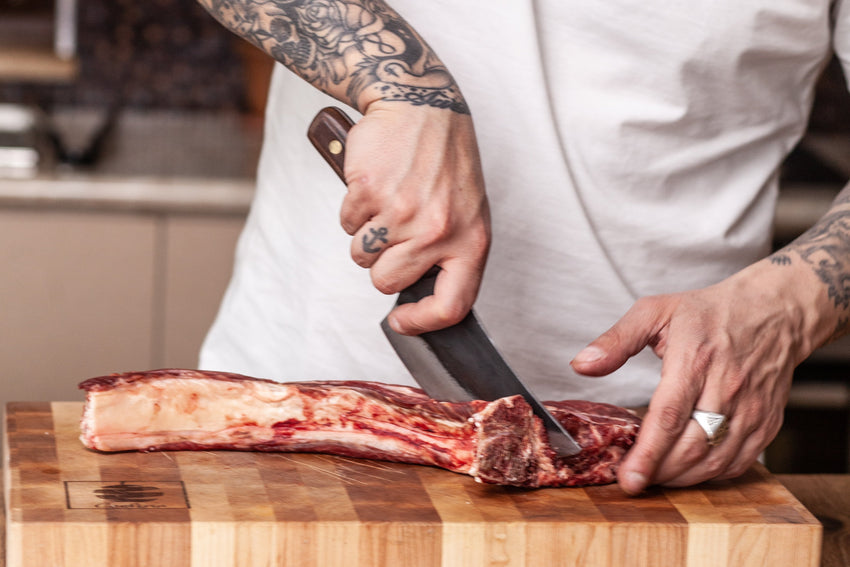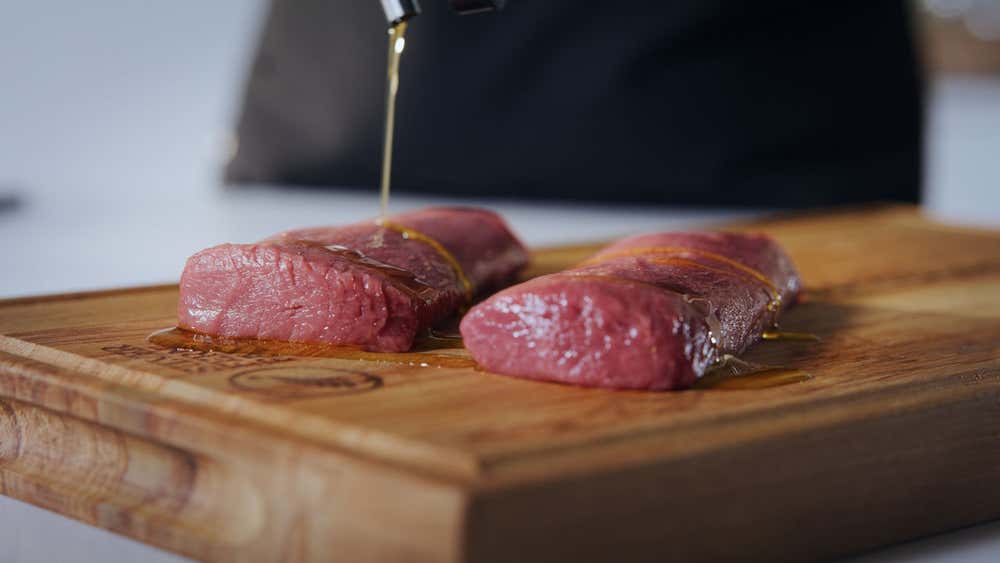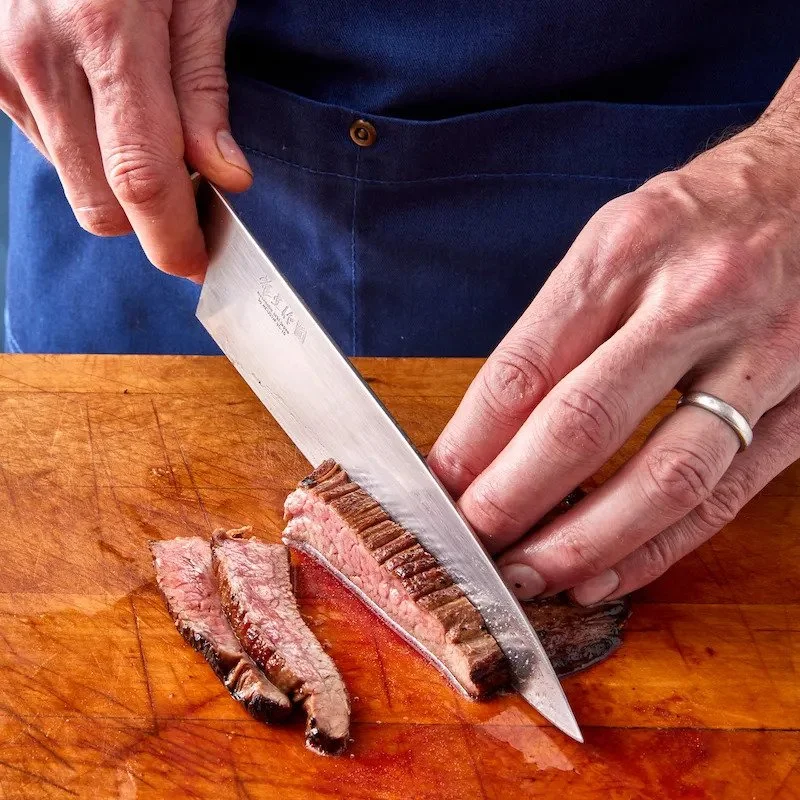Are you wondering if it’s safe to cut meat on a wooden cutting board? You’re not alone.
Many people love the look and feel of wooden boards but worry about germs and cleaning. What if your board is hiding harmful bacteria? Or what if cutting meat on wood damages your board? You’ll discover the truth about wooden cutting boards and meat.
You’ll learn how to keep your kitchen safe and your board in great shape. Keep reading to find out everything you need to know before your next meal prep.
Wooden Cutting Boards And Meat
Wooden cutting boards are popular in many kitchens. They offer a sturdy surface for cutting meat and other foods.
Knowing how wood works with meat helps keep food safe and your board in good shape.
Types Of Wooden Boards
Wooden boards come in different types. Each type has its own features that affect meat cutting.
- Maple: Hard and durable, resists deep cuts well.
- Bamboo: Eco-friendly and hard, but can be rough on knives.
- Walnut: Dark and dense, adds style and strength.
- Cherry: Smooth texture, good for light to medium use.
- Teak: Contains natural oils that resist water and bacteria.
How Wood Interacts With Meat
Wood is porous, so it can absorb juices from meat. This means cleaning is very important.
| Factor | Effect on Meat Cutting | Care Tip |
| Porosity | Can hold meat juices and bacteria | Clean board with hot water and soap |
| Wood Hardness | Affects knife marks and board wear | Choose hard wood for longer use |
| Natural Oils | Help resist moisture and bacteria | Oil board regularly to keep it sealed |
| Maintenance | Key to safe use with raw meat | Sanitize and dry board well after use |
Health Risks To Consider
Cutting meat on a wooden cutting board can cause health risks. Bacteria can grow on the wood surface. This can lead to foodborne illnesses.
It is important to understand the dangers of bacteria and cross-contamination. This helps keep your kitchen safe and clean.
Bacterial Contamination
Wooden boards can absorb juices from raw meat. Bacteria like Salmonella and E. coli may live there. These germs can stay even after washing.
- Wood is porous and can trap bacteria deep inside.
- Bacteria multiply quickly in moist areas.
- Cleaning wooden boards requires extra care.
- Improper cleaning may spread bacteria to other foods.
Cross-contamination Concerns
Cutting raw meat on wood can spread germs to other foods. This happens if you use the same board for vegetables or cooked items. This can cause sickness.
| Risk | Cause | Prevention |
| Cross-contamination | Using one board for meat and vegetables | Use separate boards for raw and cooked foods |
| Bacterial growth | Wood traps meat juices | Clean boards thoroughly with hot water and soap |
| Food poisoning | Eating contaminated food | Cook meat to safe temperatures |
Cleaning Wooden Boards Safely
Wooden cutting boards can be safe for cutting meat if cleaned properly. This helps stop germs from spreading.
Good cleaning keeps your board strong and safe for food use.
Proper Washing Techniques
Wash wooden boards right after use. Use hot water and soap to remove food bits and juices.
Scrub the board with a brush or sponge. Rinse well to remove all soap and dirt.
- Use warm water, not boiling
- Apply dish soap for cleaning
- Scrub all board surfaces thoroughly
- Rinse until no soap remains
- Dry with a clean towel or air dry
Disinfecting Methods
Disinfect wooden boards to kill bacteria after washing. Use safe household items to avoid damage.
Common disinfectants include vinegar and diluted bleach. These kill germs without harming the wood.
- Spray white vinegar on the board
- Let vinegar sit for a few minutes
- Rinse with warm water and dry
- Or use 1 tablespoon bleach in 1 gallon water
- Soak or spray the solution, wait 5 minutes
- Rinse well and air dry

Credit: www.wikihow.com
Maintenance Tips For Longevity
Cutting meat on a wooden board is common. Proper care helps keep the board safe and lasting long.
Wood can absorb liquids and odors. Good maintenance stops damage and keeps it clean.
Oiling And Conditioning
Wood boards need oil to stay strong. Oil stops the wood from drying out and cracking.
Use food-safe mineral oil or special cutting board oil. Apply it regularly for best results.
- Clean the board before oiling
- Apply oil evenly with a soft cloth
- Let the oil soak in for a few hours
- Wipe off any extra oil
- Repeat oiling once a month or more
Avoiding Cracks And Damage
Wood can crack if it dries or gets wet too much. Avoid letting water sit on the board.
Do not put wooden boards in the dishwasher. Heat and water can warp and crack the wood.
- Wash by hand with mild soap and warm water
- Dry board immediately after washing
- Store board in a dry, cool place
- Use both sides to avoid deep cuts
- Sand the surface lightly if rough or cracked
Alternatives To Wooden Boards
Wooden cutting boards are popular but not the only option for cutting meat. Some people prefer other materials for hygiene or durability.
Choosing the right board helps keep your kitchen clean and safe. Here are two good alternatives to wooden boards.
Plastic Cutting Boards
Plastic boards are easy to clean and often dishwasher safe. They do not absorb juices from meat like wood does.
These boards come in many colors. You can use different colors for meat, vegetables, and other foods to avoid cross-contamination.
- Non-porous surface
- Dishwasher safe
- Affordable and lightweight
- Available in many colors
Bamboo And Other Materials
Bamboo boards are harder and less porous than regular wood. They resist bacteria better and last long with proper care.
Other materials include glass and silicone boards. Glass is easy to clean but can dull knives. Silicone boards are flexible and non-slip.
- Bamboo is eco-friendly and durable
- Glass is hygienic but hard on knives
- Silicone is flexible and easy to store
- Each material has pros and cons

Credit: www.coolinastore.com
Best Practices For Cutting Meat
Cutting meat properly keeps food safe and tasty. Using the right tools and following hygiene rules helps prevent sickness.
Wooden cutting boards are popular but need careful handling. Learn how to use them safely for meat and other foods.
Separate Boards For Meat And Vegetables
Use different cutting boards for meat and vegetables. This stops germs from spreading between foods.
- Mark one board for raw meat only
- Use a different board for vegetables and fruits
- Clean boards well after each use
- Replace old or deeply scratched boards
Safe Handling And Storage
Keep meat cold before cutting. Store it in the fridge or freezer until you are ready.
| Handling Tip | Reason |
| Wash hands before and after touching meat | Prevent bacteria spread |
| Sanitize cutting boards and knives | Remove germs and food residue |
| Store raw meat below cooked foods | Avoid drips contaminating cooked food |
| Keep meat at or below 40°F (4°C) | Slow bacterial growth |

Credit: silverfernfarms.com
Frequently Asked Questions
Is It Safe To Cut Meat On Wood?
Yes, it’s safe to cut meat on wooden boards. Wooden boards are naturally antimicrobial, reducing bacteria risk. Ensure proper cleaning and maintenance. Use separate boards for raw and cooked meats to prevent cross-contamination. Regularly oil your board to maintain its condition and longevity.
Does Wood Harbor Bacteria From Meat?
Wooden boards can harbor bacteria if not maintained. However, they have natural antimicrobial properties. Clean them thoroughly with hot, soapy water after each use. Regularly disinfect with vinegar or a mild bleach solution. Proper care minimizes bacteria risks, ensuring safety.
How To Clean A Wooden Cutting Board?
Clean your wooden cutting board with hot, soapy water after each use. Rinse thoroughly and dry immediately. For deep cleaning, use a vinegar solution or baking soda paste. Avoid soaking in water, which can warp the wood. Regularly oil your board to prevent drying and cracking.
Can Cutting Meat Damage Wooden Boards?
Cutting meat won’t damage quality wooden boards if used properly. Use a sharp knife to minimize scratches. Avoid aggressive chopping motions. Regularly oil the board to maintain its surface. Over time, some wear is normal but doesn’t affect functionality.
Conclusion
Wooden cutting boards can be safe for cutting meat if cleaned well. They absorb less bacteria when dried quickly. Use separate boards for meat and vegetables to avoid mix-up. Regularly oil your wooden board to keep it strong and smooth.
Cutting meat on wood is fine with proper care. Keep your kitchen safe and enjoy cooking!
